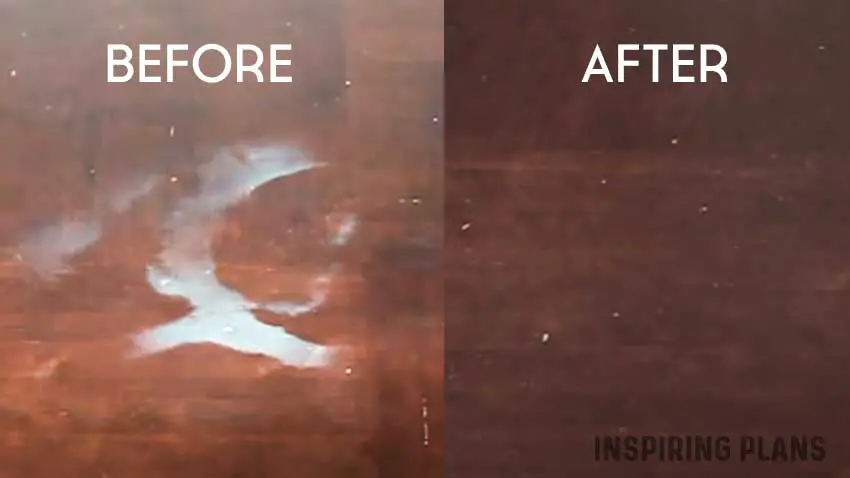It’s OK to admit it, we’ve all done it at some time, usually because we were preoccupied or in a hurry.
We’ve set a hot pizza box or a hot pan on a table with nothing under it to protect the surface.
When we moved it, we discovered a milky white stain where the offending item had sat.
This is the dreaded “Heat Stain”. Heat stains are ugly and unattractive and can ruin the appearance of wood furniture.
But don’t panic. I am about to show you how to remove heat stains from wood.
It is not as hard as you might think.
What Causes A White Heat Stain?
Heat marks don’t affect the actual wood, the damage is just in the finish.
Here is what happens…
You set something hot on the bare surface, and it causes water to form in the layer of finish, creating tiny pockets of air and water that appear as a milky film.
The wood itself is undamaged, unless the stain goes dark.
The longer you leave these white stains, the greater the chance moisture will seep into the wood and cause wood rot in your furniture.
It’s best to get heat spots off wood as soon as possible, the trick is for you not to damage the wood in the process.
We can do this by removing the tiny pockets of air and water from the finish.
The goal is to remove the trapped air and moisture in the finish to remove white heat marks.
5 Way To Remove Heat Stains From Wood Furniture
Different methods work on different woods and finishes, so you may have to determine what is best for your wood table or counter.
Getting rid of white heat stains is mostly trial and error.
The basic techniques are:
The Steam Iron Method
Heat breaks down the wood finish allowing the air and moisture to escape.
This is a good method to remove heat stains from wooden furniture, but you do have to exercise a little caution to avoid burning the wood.
Simply take a clean towel and place it over the spot.
Using a hot steam iron, slowly work over the area using lots of steam.
Make sure to keep the iron moving so as not to burn the wood or burn your towel onto the surface. Check your progress frequently, and 90% of the time, this will remove the stain.
When finished, take a clean brush, and lightly feather the mark so the moisture can evaporate. Do not wipe the area until it is dry, or you may smear the finish.
This video is great because it shows how they started with less heat and gradually increased until the iron technique started working. You should do the same to make sure you don’t burn your wood table.
The Blush Remover Method
Another easy method has the added advantage of no danger of burning the finish. On the down-side, you have to buy something.
There are many brands of Blush Remover available at your local grocery or hardware store.
My two favorites are Mohawk No Blush, and Behlen Blush Eraser.
If you can’t find them in your area, you can will be able to find them online.
To use, simply spray the stain with the blush remover enough to make it wet, and allow it to set until the mark melts away.
Lightly feather the mark with a soft brush to help the solution to evaporate. Do not wipe until the area is completely dry.
This is by far, the best method. These types of products could even support a side business restoring furniture. Scott Grove spills the beans on Mohawk No Blush Retarder in this great YouTube demo:
The Mayonnaise Method
This is one my grandmother always said worked, but it never worked for me. If you want to try it, simply squeeze or dollop some mayonnaise (don’t know if salad dressing or Miracle Whip will work she never said…) on a clean soft cloth or paper towel.
Wipe it into the stained area and let it set for around 4 hours or so.
Wipe off with a clean cloth or paper towel.
There are mixed reviews on the mayonnaise method. Some people say it works, others don’t.
If it doesn’t work, refer to methods 1 and 2.
Vinegar and Olive Oil
Another old-time method. Mix vinegar and water about half and half, then rub it liberally on the stained area.
These home remedy methods tend to work best with the damage is not very deep.
Olive oil might be worth a try if your heat stain is fresh and seems to be only surface level damage.
Toothpaste and Baking Soda
While toothpaste and baking soda work like magic on some things, like cleaning iron cookware, I’ve never had any luck with it at removing heat stains from wooden furniture.
If you want to try it, just mix toothpaste and baking soda together, about half and half, and liberally apply the paste to the stained area, and keep rubbing, and rubbing… and rubbing… in the direction of the wood grain.
In this case, toothpaste and baking soda is working as an abrasive. The finish on your wood has a depth to it. The toothpaste removes the very top layer of the finish and if the damage is on this surface this might be enough to remove the heat stain from your furniture.
Your mileage may vary, it certainly worked in this example:
Conclusion
It stands to reason that the very best method to not have white heat marks on wood furniture is to prevent them from happening in the first place.
Always use a heat-resistant place setting to set hot stuff on, and you shouldn’t ever have to deal with heat stains.
If you get take-out pizza remember that the cardboard box won’t protect your table. Many people seem to get caught out by hot pizza boxes.
